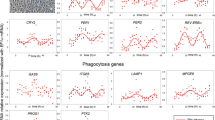Abstract
IN the vertebrate retina the light-sensitive rod outer segments (ROS) are composed of stacks of double membrane ‘disks’ surrounded by a plasma membrane. Throughout life, the ROS membranes are renewed in a highly ordered manner which has made this cell type the model of choice for many studies on membrane synthesis and turnover. Autoradiographical studies have shown that new membrane precursors are synthesised within the rod inner segment, then assembled into new disks at the base of the ROS, displacing previously formed disks away from the cell body1,2. An optimum ROS length is maintained by the periodic shedding of groups of older disks from the ROS tip. These discarded disk packets are then engulfed and degraded by the adjacent pigment epithelium3,4. The shed ROS fragments persist for several hours within the cytoplasm of the pigment epithelial cells and are referred to as phagosomes.3 LaVail5 has reported that ROS in the rat retina shed their apical tips shortly after the onset of light in animals maintained under cyclic lighting (12h light (L):12h dark (D)). We have shown that a similar pattern of rod outer segment shedding occurs in the amphibian retina6–8, and similar patterns have also been observed in the goldfish9, rabbit10 and chick11. In all these animals, a nearly synchronous burst of ROS shedding occurs within two hours of the onset of light, and minimal amounts of rod shedding occur during the remainder of the day. Also, in amphibians, constant light inhibits daily rod shedding, and the outer segments elongate due to continued outer segment disk addition7,12,13. In the rat5 and Xenopus7, shedding occurs at approximately the same time each day in animals maintained for several days in the dark, although in Rana the onset of light is required to initiate shedding, and dark-maintained animals do not shed for several days6. Taken together, these results have suggested that ROS shedding follows a circadian rhythm related to the onset of the light cycle. The photoreceptive nature of the amphibian pineal gland, and the well-documented circadian rhythm in serotonin–melatonin metabolism in the rat pineal, made this organ a particularly good candidate for controlling photoreceptor shedding, although several other extraocular systems have been suggested14. However, several laboratories have demonstrated that pinealectomy, hypophysectomy, superior cervical ganglionectomy, and cutting of the optic nerves have no effect on the diurnal pattern of ROS shedding in either the rat or the frog retina12,15. Furthermore, we have been unable to affect rod shedding in the frog retina by direct injection of melatonin, serotonin or the β-adrenergic effectors propranolol and iso-prenaline. Thus, even though rod outer segment shedding consistently occurs in both eyes and seems to follow a circadian rhythm in darkness, suggesting some form of central regulation, the intraocular control of this response remained a possibility. We report here experiments which strongly suggest that rod shedding in frogs can be initiated within the eye and is not secondarily controlled by a gland or organ elsewhere in the body.
This is a preview of subscription content, access via your institution
Access options
Subscribe to this journal
Receive 51 print issues and online access
$199.00 per year
only $3.90 per issue
Buy this article
- Purchase on Springer Link
- Instant access to full article PDF
Prices may be subject to local taxes which are calculated during checkout
Similar content being viewed by others
References
Young, R. W. J. Cell Biol. 33, 61–72 (1967).
Young, R. W. & Droz, B. J. Cell Biol. 39, 169–184 (1968).
Young, R. W. & Bok, D. J. Cell Biol. 42, 392–403 (1969).
Ishikawa, T. & Yamada, E. J. Electron Microsc. 19, 85–99 (1970).
LaVail, M. M. Science 194, 1071–1074 (1976).
Basinger, S., Hoffman, R. & Matthes, M. Science 194, 1074–1076 (1976).
Besharse, J. C., Hollyfield, J. G. & Rayborn, M. E. J. Cell Biol. 75, 507–527 (1977).
Hollyfield, J. G., Besharse, J. C. & Rayborn, M. E. J. Cell Biol. 75, 490–506 (1977).
O'Day, W. T. & Young, R. W. J. Cell Biol. 76, 593–604 (1978).
Bunt, A. H. Invest. Ophthal. vis. Sci. 17, 90–104 (1978).
Young, R. W. Invest. Ophthal. vis. Sci. 17, 105–116 (1978).
Currie, J. R., Hollyfield, J. G. & Rayborn, M. E. Vision Res. (in the press).
Basinger, S. F. in Frontiers in Visual Science (ed. Cool, S. J.) (Springer, New York, 1978).
Hollyfield, J. G. & Basinger, S. F. Invest. Ophthal. vis. Sci. 17, 87–89 (1978).
Tamai, M., Teirstein, P., Goldman, A. I., O'Brien, P. J. & Chader, G. Invest. Ophthal. vis. Sci. 17, 558–562 (1978).
Author information
Authors and Affiliations
Rights and permissions
About this article
Cite this article
HOLLYFIELD, J., BASINGER, S. Photoreceptor shedding can be initiated within the eye. Nature 274, 794–796 (1978). https://doi.org/10.1038/274794a0
Received:
Accepted:
Issue Date:
DOI: https://doi.org/10.1038/274794a0
This article is cited by
-
A high content, small molecule screen identifies candidate molecular pathways that regulate rod photoreceptor outer segment renewal
Scientific Reports (2018)
-
Circadian clock in Xenopus eye controlling retinal serotonin N-acetyltransferase
Nature (1983)
-
Light-dependent plasticity of the morphology of horizontal cell terminals in cone pedicles of fish retinas
Journal of Neurocytology (1980)
Comments
By submitting a comment you agree to abide by our Terms and Community Guidelines. If you find something abusive or that does not comply with our terms or guidelines please flag it as inappropriate.



